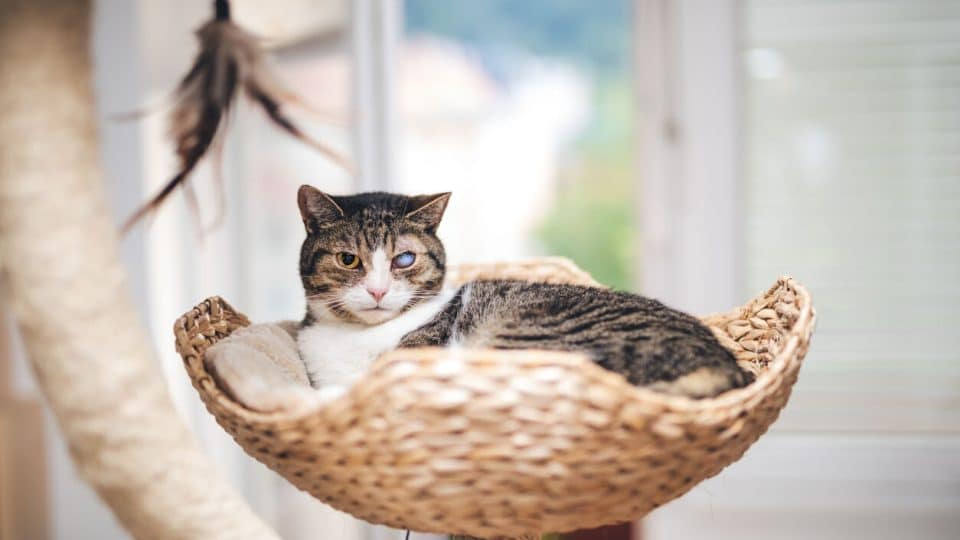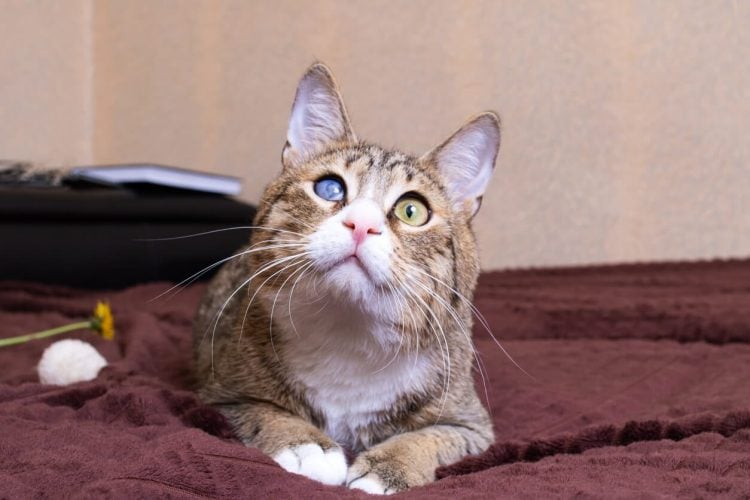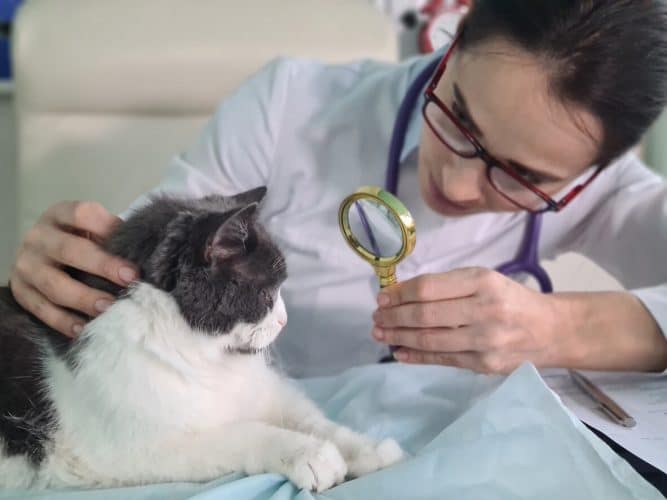- Not a substitute for professional veterinary help.
Does your cat’s eye seem hazy, like a fogged-up crystal ball? If so, you may have spotted one of the most telltale signs of cataracts in cats.
With this condition, the lens of a cat’s eye becomes cloudy. Since the lens helps filter light to the retina and optic nerve, cataracts prevent light from passing through the eye to the retina. As a result, your cat can lose some or all of their vision in the affected eye.
While this may sound scary, don’t panic—treatment can help your cat!
“Although it may not always be possible to preserve vision in cats with cataracts, numerous treatment options exist that allow them to live safe and comfortable lives,” says Dr. Jennifer Sperry, DVM, veterinary advisor at Pets Plus Us.
Learn more about the symptoms and causes of cataracts in cats below. Plus, discover the potential treatment options and get tips on keeping your cat happy and safe at home.
Signs Of Cataracts In Cats
The trademark sign of cataracts is the visual change in the eye.
“Your cat’s eyes may appear cloudy, whitish, or bluish, especially in the area of the pupil,” Dr. Sperry says. The cloudiness can appear in only part of the eye or the whole eye. It can also affect one or both eyes.
Beyond the visual signs, changes in your cat’s behavior can also suggest they’re having vision problems. For example, they might:
- Bump into furniture
- Have trouble finding familiar places, like food bowls or the litter box
- Jump and climb less, miss jumps, or seem less agile
- Seem hesitant to use stairs or avoid them entirely
How Do Vets Diagnose Cataracts?
“Cataracts are diagnosed using the visible changes in the appearance of the eye’s lens,” Dr. Sperry says.
To make a definitive assessment, Dr. Sperry says that your vet will likely dilate your cat’s eye with eyedrops and then examine their eye with an ophthalmoscope. It’s also typical for a vet to run basic bloodwork tests to check your cat’s hormone and organ health, Dr. Sperry says.
What Causes Cataracts In Cats?
Feline cataracts are actually fairly rare.
“Cataracts are considerably less common in cats than they are in dogs,” explains Dr. Casey Robinson, DVM, an ophthalmological veterinarian and the area medical director for IndeVets.
While dogs can develop cataracts for no apparent reason, cataracts usually have an underlying cause in cats, such as one of the following.
Inflammation
The most common cause of cataracts is inflammation in the eye, or uveitis. This inflammation often happens as a result of viral, bacterial, or fungal infections. Parasites, like toxoplasmosis, can also cause eye inflammation.
High blood pressure
Dr. Sperry says that hypertension, or high blood pressure, often contributes to cataracts in cats. This is because increased pressure in the blood vessels can injure organs and tissues in a process called “target organ injury,” and the eyes are the usual targets.
Diabetes
Some cats can also get cataracts as a side effect of diabetes, although this happens far more often for dogs. In fact, an older study of cats and dogs with diabetes found that more than half of the dogs had cataracts while none of the cats were affected.
Genetics and age
Sometimes, a cat’s genetic makeup can make them more susceptible to cataracts.
Breeds who are more likely to get cataracts include Russian Blue, Persian, and Bengal cats. Genetic cataracts usually affect younger cats and kittens.
Some cats can also develop cataracts as a result of old age.
How To Treat Cataracts In Cats
“Vets need to know about the health of the entire eye and the whole patient when they make a treatment plan for cataracts,” Dr. Sperry explains.
For example, if your cat develops cataracts because of an underlying health issue, like high blood pressure, then your vet may suggest treating their high blood pressure with medication and a new diet.
Other ways to treat or manage cataracts in cats include the following.
Surgery
Some cats may qualify for cataract surgery that replaces the cloudy lens with an artificial one. This can effectively reverse the cataracts and help your cat see again.
Cataract surgery is effective in about 9 out of 10 pets. However, your cat’s eyes need to be healthy enough for your vet to consider surgery.
For example, some cats develop glaucoma, or increased pressure in the eye, after getting cataracts. Glaucoma can be very painful and doesn’t respond well to medical treatment, and some cats may only get relief from surgery that removes the affected eye. Your vet can recommend ways to help lower your cat’s risk of developing glaucoma.
Eye drops
Your vet may suggest anti-inflammatory eyedrops to ease inflammation in your cat’s eyes. While these eye drops won’t reverse cataracts, Dr. Sperry says that they can help keep existing ones from getting worse.
Eyedrops can also help prevent cats from developing secondary conditions, including glaucoma.
Tip: Some pet insurance plans may help cover the cost of treatment for cataracts and other eye problems.
How To Help Your Low-Vision Cat Live A Full, Happy Life
While it may not always be possible to preserve full vision in a cat with cataracts, Dr. Sperry says they can still live happy lives. You may need to make a few changes at home to help them adjust to their new vision level.
These tips can help your blind or low-vision cat adjust:
- Block off hazards: Dr. Robinson suggests blocking off danger zones, like staircases, with baby gates to prevent falls. You can also add mobility aids, like cat ramps, to help your kitty get on the couch or bed without jumping.
- Try a “halo” harness: Until your cat gets used to navigating the house without sight, you can try outfitting them with a “halo” harness. These come with a lightweight ring that absorbs the impact when they bump into an object—something like a bumper car.
- Keep them inside: Dr. Robinson suggests keeping blind cats indoors, although you can always try an enclosed catio to let them enjoy fresh air and outside smells.
- Try new landmarks: If your kitty can no longer spot visual landmarks in the house, try giving them tactile or auditory markers to find their way. For example, hang windchimes in the doorway or mark food bowls and litter boxes with textured mats.
Of course, plenty of love and cuddles can also show your cat that you’ll always be there to support them—whether their eyes are cloudy or clear.





